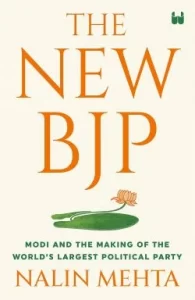
MELBOURNE, 26 April 2022: This ‘In Conversation’ Zoom event discussing Nalin Mehta’s recently released book, “The New BJP: Modi and the making of the world’s largest political party” (Westland, 2022), organized by the La Trobe University was an introduction to the book which deals with the riddle of the rise of Modi and the BJP since 2014. Dr.Ian Woolford, Lecturer, Hindi Studies, La Trobe University asked the obvious questions which Dr. Nalin Mehta detailed aptly.
Dr. Nalin Mehta, Dean, School of Modern Media, UPES, Advisor, Global University Systems and Non-Resident Senior Fellow, Institute of South Asian Studies, National University Singapore, in the book, as he explained, 2014 was a watershed moment in Indian politics as new classes of voters emerged which gave the BJP led by Modi a clear majority of its own in the Lok Sabha and the repeat and better electoral performance in 2019.
The political, social, caste, and other equations before 2014 changed, and the new realities took over, says Dr. Nalin Mehta. It is this, he says, is analyzed through a new NARAD index, social media analysis, caste equations and economic indicators. This discounted the liberal assumption that the BJP was essentially only a Hindu nationalist upper caste party. Dr. Nalin Mehta says, now the BJP had in rural areas a new constituency of voters, except the Muslims. These were the non-Yadav OBCs, not-Jatav Dalits and women. In the 2019 elections women, voters’ turnout was higher than men and that suited the BJP.

Other factors that helped the BJP was the mobile phone revolution, cheap data, and the Aadhar system, introduced in January 2013. Plus, Dr. Nalin Mehta says, the party used welfare schemes and in the North-East its success lies in the policy of merger and alignment with other parties.
The author’s basic assertion, as he says, is the BJP used many methods to come to power, it was not just ‘Hindutava’, its core ideology. How many percent of voters understand the difference between ‘Hinduism’ and ‘Hindutava’? The author says the party is not apologetic about ‘Hindutava’ – Ram temple, triple talaq, Article 356…, in fact, hard-line about it. Probably, ‘The New BJP’.

Also, it’s generally believed Modi’s personality also played a big role in BJP’s current rise. So, the personality cult and the separation of actual performance and voting behavior also need to be explained. The story seems to be having many dimensions.
I am sure there is much more in the book and, in fact, the author has also listed five challenges for the BJP – economy, leadership after Modi, new caste combinations, China and the Hindu-Muslim divide.
This was an informative event by La Trobe University. Dr.Ian Woolford’s questions were simple and pointed. Dr. Nalin Mehta’s research raises vital questions about India and South Asia’s democratic happenings in the information age. The role of leadership style and information tech laced with faith populism and welfare makes the subject thought-provoking.




